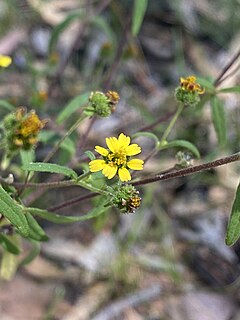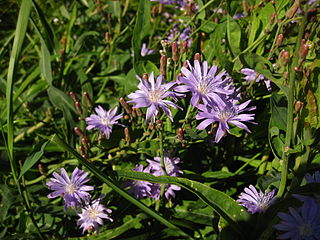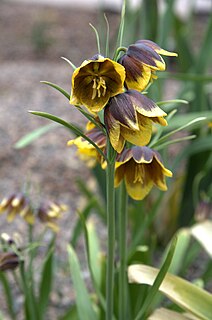
Gundelia is a low to high (20–100 cm) thistle-like perennial herbaceous plant with latex, spiny compound inflorescences, reminiscent of teasles and eryngos, that contain cream, yellow, greenish, pink, purple or redish-purple disk florets. It is assigned to the family Asteraceae. Flowers can be found from February to May. The stems of this plant dry-out when the seeds are ripe and break free from the underground root, and are then blown away like a tumbleweed, thus spreading the seeds effectively over large areas with little standing vegetation. This plant is native to the eastern Mediterranean and the Middle-East. Opinions differ about the number of species in Gundelia. Sometimes the genus is regarded monotypic, Gundelia tournefortii being a species with a large variability, but other authors distinguish up to nine species, differing in floret color and pubescence. Young stems are cooked and eaten in the Middle-East and are said to taste like a combination of artichoke and asparagus. The plant also contains compounds that have been demonstrated to be effective against a range of ailments. A large quantity of pollen assigned to Gundelia has been found on the Shroud of Turin, which may suggest that the crown of thorns was made from Gundelia, but this finding has been contested.

Lactuca, commonly known as lettuce, is a genus of flowering plants in the family Asteraceae. The genus includes at least 50 species, distributed worldwide, but mainly in temperate Eurasia.

Pierre Edmond Boissier was a Swiss prominent botanist, explorer and mathematician. He was the son of Jacques Boissier (1784-1857) and Caroline Butini (1786-1836), daughter of Pierre Butini (1759-1838) a well-known physician and naturalist from Geneva. With his sister, Valérie Boissier (1813-1894), he received a strict education with lessons delivered in Italian and Latin. Edmond's interest in natural history stemmed from holidays in the company of his mother and his grandfather, Pierre Butini at Valeyres-sous-Rances. His hikes in the Jura and the Alps laid the foundation of his zest for later exploration and adventure. He attended a course at the Academy of Geneva given by Augustin Pyramus de Candolle.

Lactuca serriola, also called prickly lettuce, milk thistle, compass plant, and scarole, is an annual or biennial plant in the tribe Cichorieae within the family Asteraceae. It has a slightly fetid odor and is commonly considered a weed of orchards, roadsides and field crops. It is the closest wild relative of cultivated lettuce.

Lactuca muralis, the wall lettuce, is a perennial flowering plant in the tribe Cichorieae within the family Asteraceae, also referred to as Mycelis muralis.
Ulmus boissieriGrudz.,, a disputed species of elm found in Iran, was identified by Grudzinskaya in 1977. She equated her "new species" with the U. campestris f. microphylla collected in 1859 in Kerman Province and described in his Flora Orientalis (1879) by Boissier, for whom she named it, treating Boissier's specimen as the "type". The tree is endemic the provinces of Kermanshah and Kerman., and also the Zagros forests, growing with Quercus brantii, Celtis australis, Platanus orientalis, Fraxinus sp., and Cerasus mahaleb.
Cephalorrhynchus is a genus of flowering plants in the dandelion family.

Notholirion is a small Asian genus of bulbous plants in the lily family, Liliaceae. It is closely related to Lilium, but each individual flowers only once, and then dies after producing offsets. The bulb is covered by a tunic. Leaves are basal, produced in autumn and winter.

Sigesbeckia orientalis, commonly known as Indian weed or common St. Paul's wort, is a species of flowering plant in the family Asteraceae. It is a small, upright, sparsely branched shrub with yellow flowers and widespread in Asia, Africa and Australia.

Lactuca tatarica, known as blue lettuce, is a Eurasian flowering plant in the tribe Cichorieae within the family Asteraceae. It is widespread across much of Europe and Asia.
Allium achaium is a plant species endemic to Greece.
Lactuca dissecta, the split-leaf lettuce, is an Asian species of plant in the tribe Cichorieae within the family Asteraceae. It is native to Central Asia, western China, the Himalayas, and southwest Asia as far west as Turkey.
Allium cassium is a species of flowering plant in the Amaryllidaceae family. It is a wild onion native to Turkey, Lebanon, Israel, and Cyprus.

Fritillaria gibbosa is a species of herbaceous perennial plant in the lily family Liliaceae. It is native to Afghanistan, Iran, Pakistan, Turkmenistan, and Transcaucasia.

Lactuca viminea, the pliant lettuce, is a Eurasian plant species in the tribe Cichorieae within the family Asteraceae. It is widespread across much of Europe and southwestern Asia from Portugal to Pakistan.
Lactuca graminifolia, the grassleaf lettuce is a North American species of wild lettuce. It grows in Mexico, Central America, Hispaniola, and the southern United States from Arizona to Florida, Virginia and the Carolinas.

Hymenonema laconicum is a species of herbaceous perennial plant in the Asteraceae family. It is small to average height, with a rosette of greyish pinnately segmented leaves, and little branching solid stems carrying one to three heads of orange or yolk yellow ray-flowers, with a purple anther tube, and scaly pappus. The species is an endemic of the central and south-eastern Peloponnesos, and flowers in May and June.

Scorzonera libanotica, also known as the Lebanese salsify and Lebanese viper's grass is a perennial member of the genus Scorzonera in the sunflower family (Asteraceae).

Fritillaria reuteri is a perennial herbaceous bulbous plant, distributed in Turkey and Iran. It is a species in the genus Fritillaria, in the family Liliaceae. It is placed in the subgenus Fritillaria.
Digitalis cariensis is a species of flowering plant in family Plantaginaceae. It is a type of foxglove. It is native from southwestern to southern Turkey.












